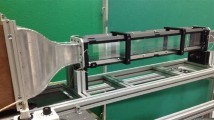Abstract
An ultra-high speed, time-resolved particle image velocimetry (PIV) system is developed to measure velocity fields created by explosive detonators. When initiated into a gas, the detonators generate blast waves that propagate outwards from the origin of initiation at supersonic speeds. The PIV system consists of a custom eight-pulse Nd:YAG laser system and an ultra-high speed camera system comprising four dual-frame CCD cameras optically combined to share a single optic axis. The system is capable of sampling the flow field four times at up to 333 MHz or eight times at up to 8 MHz. System development is discussed, and preliminary application to the complex flow behind the blast wave from an exploding bridge wire detonator is demonstrated.










Similar content being viewed by others
References
Adrian RJ, Yao CS (1985) Pulsed laser technique application to liquid and gaseous flows and the scattering power of seed materials. Appl Opt 24:44–52
Adrian RJ (1995) Limiting resolution of particle image velocimetry for turbulent flow. Advances in Turbulence Research 1–19
Beutner T, Adelgren R, Elliott G (2006) Characterization of schlieren light source using laser-induced optical breakdown in argon. AIAA J 44:399–402
Cooper PW (1996) Explosives engineering. Wiley-VCH, New York
Echols WH, Young JA (1963) Studies of portable air-operated aerosol generators. NRL Report 5929 (US Naval Research Laboratory, Washington)
Elsinga GE, van Oudheusden BW, Scarano F (2005) Evaluation of aero-optical distortion effects in PIV. Exp Fluids 39:246–256
Gamal YE, Shafik MS (1993) Electrical breakdown in argon by powerful pulses of ultraviolet laser radiation. J Phys D Appl Phys 26:767–772
Hijazi A, Madhavan V (2008) A novel ultra-high speed camera for digital image processing applications. Meas Sci Technol 19:085503
Lin SC (1954) Cylindrical shock waves produced by instantaneous energy release. J Appl Phys 25:54–57
McKeon BJ, Comte-Bellot G, Foss JF et al (2007) Velocity, vorticity, and mach number. In: Tropea C, Yarin AL, Foss JF (eds) Handbook of experimental fluid mechanics. Springer, Berlin
Melling A (1997) Tracer particles and seeding for particle image velocimetry. Meas Sci Technol 8:1406–1416
Murphy MJ, Adrian RJ (2010) PIV through moving shocks with curved geometry. Manuscript in review for Exp Fluids
Murphy MJ, Adrian RJ (2007) Particle response to shock waves in solids: dynamic witness plate/PIV method for detonations. Exp Fluids 43:163–171
Murphy MJ, Adrian RJ, Stewart DS, Elliott GS, Thomas KA, Kennedy JE (2005) Visualization of blast waves created by exploding bridge wires. J Vis 8(2):125–135
Nobach H, Bodenschatz E (2009) Limitations of accuracy in PIV due to individual variations of particle image intensities. Exp Fluids, Online First
PCO (2004) HSCF-Pro operating instructions
Reu PL, Miller TJ (2008) The application of high-speed digital image correlation. J Strain Anal 43:673–688
Romanova VM, Tkachenko SI, Barishpoltsev DV, Ivanenkov GV, Ter-Oganesyan AE, Mingaleev AR, Shelkovenko TA, Pikuz SA (2007) Mechanisms of shock wave generation and different scenarios of second breakdown development upon electrical explosion of wires. 34th EPS Conference on Plasma Physics, Warsaw, Poland, July 2–6, paper P-5.050
Scarano F, van Oudheusden BW (2003) Planar velocity measurements of a two-dimensional compressible wake. Exp Fluids 34:430–441
Settles GS (2001) Schlieren and shadowgraph techniques. Springer, New York
Spedding GR, Rignot EJM (1993) Performance analysis and application of grid interpolation techniques for fluid flows. Exp Fluids 15:417–430
Oshima K (1960) Blast waves produced by exploding wire. Aeronautical Research Institute Report 358 (University of Tokyo)
Wereley ST, Meinhart CD (2001) Second-order accurate particle image velocimetry. Exp Fluids 31:258–268
Yan H, Adelgren R, Boguszko M, Elliott G, Knight D (2003) Laser energy deposition in quiescent air. AIAA 41:1988–1995
Acknowledgments
Funding was provided by the Joint DOD/DOE Munitions Program. Los Alamos National Lab is operated by Los Alamos National Security, LLC, under Contract No. DE-AC52-06NA25396 with the U.S. Department of Energy. The authors wish to thank Jon Baltzer for his technical assistance during data analysis.
Author information
Authors and Affiliations
Corresponding author
Rights and permissions
About this article
Cite this article
Murphy, M.J., Adrian, R.J. PIV space-time resolution of flow behind blast waves. Exp Fluids 49, 193–202 (2010). https://doi.org/10.1007/s00348-010-0843-y
Received:
Revised:
Accepted:
Published:
Issue Date:
DOI: https://doi.org/10.1007/s00348-010-0843-y




